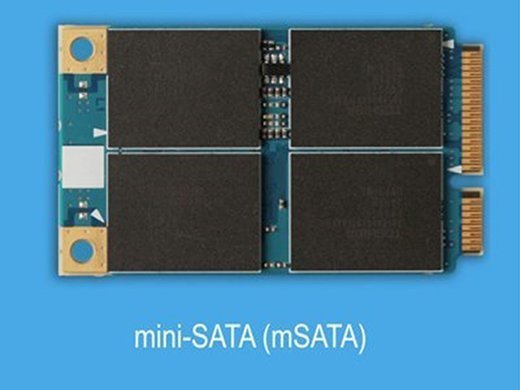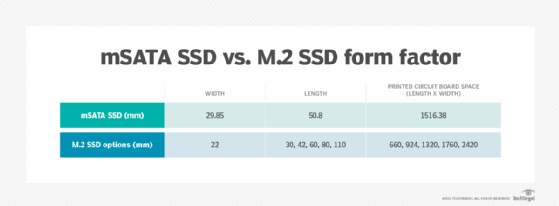mSATA SSD (mSATA solid-state drive)
What is mSATA?
An mSATA SSD is a solid-state drive (SSD) that conforms to the mSATA interface specification developed by the Serial ATA (SATA) International Organization.
An mSATA SSD has a smaller form factor than a standard SSD and is designed for use with portable, power-constrained devices such as laptops, tablets and netbooks. Although they can still be found in older laptops and devices, mSATA SSDs are increasingly being replaced by M.2 SSDs. The mSATA SSD flash storage device is still used in commercial products such as digital signs, point-of-sale devices, retail kiosks and multifunctional printers.
An mSATA SSD is roughly the size of a business card. Advantages of mSATA SSDs include a small form factor, lower power consumption than a standard SSD, shock and vibration resistance, and fast boot and shutdown capabilities. The maximum bandwidth of an mSATA SSD is 6 gigabits per second (Gbps).

As an internal solid-state drive designed with lightweight construction in mind, an mSATA is 50.8 mm x 29.85 mm x 4.85 mm. It supports all three revisions to the SATA interface specification, with drive performance ranging from 1.5 Gbps to 6 Gbps.
How is mSATA used?
MSATA SSDs were developed for use where their small form factor would be beneficial -- for example, in ultra-thin laptops. MSATA devices can also act as a cache drive, speeding up access to frequently accessed data and applications.
Examples of mSATA devices
Although often replaced by M.2 SSDs, mSATA SSDs can still be found in the following devices:
- notebooks;
- tablets;
- phone conference systems;
- GPS devices;
- automated care devices;
- electronic patient records systems;
- drive caches; and
- electronic smartboards.
What features does mSATA have?
MSATA SSDs provide the following features:
- Speed. Read and write speeds can reach up to around 551 Mbps and 304 Mbps, respectively. MSATAs have a maximum bandwidth of 6 Gbps.
- Capacity. Storage capacity options typically range from 8 GB to 512 GB, but mSATA SSDs can also reach up to 1 TB, which is comparable to some storage devices today.
- Reliability. MSATA SSDs are typically known for their reliability in data storage and can last from 1.5 to 2 million hours. Protective cases on these SSDs also add resistance from external shock and vibration.
Other features of mSATA drives can include end-to-end data protection, inclusion of error correction code and cyclic redundancy checks.
What is the difference between SATA vs. mSATA?
The SATA International Organization (SATA-IO) started developing the mini interface connector in 2009. The mSATA specification emerged in 2011 as part of SATA revision 3.1. Vendors that contributed to the mSATA specification included Dell EMC, Hewlett Packard Enterprise, Lenovo, Samsung, SanDisk, Toshiba and STec Inc., which was acquired in 2013 by HGST, a Western Digital company.
SATA-IO initially referred to the specification as mini-SATA, but the organization later called it mSATA. The mSATA specification describes how to map SATA signals onto a Peripheral Component Interconnect Express (PCIe) mini-card connector to enable use with a wide range of applications.
Like SATA, mSATA uses the Advanced Technology Attachment (ATA) command set to transfer data between a host computer and a target storage device. The main differences between an mSATA SSD and a SATA SSD are physical size and the connector. A SATA is thicker compared to an mSATA SSD with a 2.5-inch casing.
Limited by the smaller form factor, an mSATA SSD typically has less storage capacity than a SATA SSD. However, their read and write speeds are similar.
How do you test mSATA?
Users can test mSATA SSDs with software tools. These tools can determine if an SSD is faulty, providing either a pass or fail result. Most health check tools can examine both sequential and random read and write speeds, power consumption, file transfer speeds and general performance.
But not every test tool has these features, and not every test tool can test every SSD, so it is best to check the testing software's description before downloading. For example, Samsung Magician Software tests Samsung M.2 and mSATA SSDs. It can help users monitor, manage and secure data through performance benchmarks, diagnostic scans, performance optimization and overprovisioning. Other monitoring tools are available, including the free open source CrystalDiskInfo app.
What is the difference between M.2 SSD vs. mSATA SSD?
M.2 SSDs and mSATA SSDs are both high-performance storage devices designed for use with small devices such as notebooks and tablet computers. The M.2 form factor emerged in 2013, approximately two years after the mSATA specification. M.2 was developed to supersede the mSATA format. The PCI Special Interest Group consortium of technology vendors defined the M.2 specification.
Some of the differences between M.2 and mSATA SSDs include:
- MSATA SSDs only use the SATA interface, while M.2 SSDs support SATA or PCIe interfaces.
- The newer M.2 form factor offers different sizes, compared to mSATA SSDs that ship in only one size. Half-size mSATA SSDs are also available. They are 30.1 mm x 26.8 mm and provide up to 152 MBps read times and 64 MBps write times.
- An M.2 SSD is faster, as it can extend the data ratebeyond the 6 Gbps limitation of an mSATA SSD. A PCIe-based M.2 SSD can support up to four lanes of PCIe at a per-lane rate of up to 1 Gbps.
- 2 SSDs also increase performance. They support non-volatile memory express, or NVMe, which can boost performance and reduce latency over devices that use the ATA or Small Computer System Interface command set.
- Although both SSD types have small form factors, M.2 drives typically have higher storage capacities.

M.2 SSDs also support SATA Express (SATAe), which enables SATA or PCIe connectors. The SATAe-based M.2 drive tells the host if it is PCIe or SATA.
The technology industry has largely shifted to M.2s over mSATA SSDs. M.2 SSDs are used in client devices and, to a lesser degree, in enterprise systems.
What is the difference between mSATA vs. mini PCIe?
An mSATA SSD is similar in size and appearance to a mini PCIe card (mPCIe), and both can physically fit into the same mPCIe slot on the motherboard. But sharing the same size and form factor makes it possible to confuse the two.
MPCI-e cards can be used to connect wireless adapters, solid-state device storage and other performance boosters for laptops and mobile devices. PCIe is a point-to-point technology in which each serial link has a full duplex pair of differential signals, known as a lane. PCIe supports up to 32 lanes, but mPCIe supports only one.
An mPCIe uses PCI Express signals for desktop expansion cards, while comparatively, mSATA uses the SATA storage interface for SSDs.
MSATA SSDs also use the SATA storage bus interface and must have a direct connection to the SATA host controller. Meanwhile, mPCIe cards support PCIe and universal serial bus signals.
Even though an mSATA card can be slotted into an mPCIe slot, they are not compatible devices. They will not work properly if switched because of the different connection protocols each uses. But using a SATA host controller can make some mSATA cards compatible with mPCIe slots.

Learn more in this article about the common SSD form factors and where each is used, including SATA, mSATA and M.2 SSDs.






